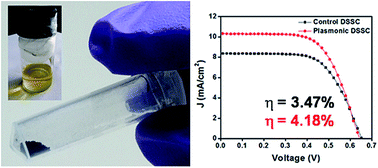Solid state plasmonic dye sensitized solar cells based on solution processed perovskite CsSnI3 as the hole transporter†
Abstract
Perovskite CsSnI3 was synthesized by a facile low temperature solution based method and used as a hole transport material in solid state dye sensitized solar cells (ss-DSCs). DSCs with an efficiency of ∼3.5% were fabricated in this fashion. Further, by adopting a plasmonics concept for enhancing the absorption process in the device, gold nanoparticles with optimized concentration having an average size ∼18 nm were mixed in TiO2 paste to fabricate plasmonic ss-DSCs. An enhancement of ∼23% in photocurrent was observed and an efficiency of ∼4.2% was obtained for the case of plasmonic ss-DSCs fabricated with an Au–TiO2 weight ratio of 0.3 wt%. Electrochemical impedance spectroscopy study revealed enhanced electron lifetimes for plasmonic ss-DSCs, which are due to the accelerated charge transport under the Au NPs' plasmon near-fields leading to a reduction in transport resistance and the recombination process.


 Please wait while we load your content...
Please wait while we load your content...